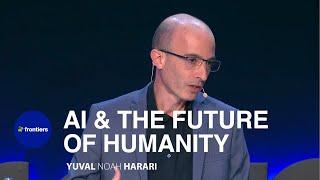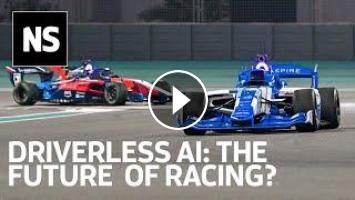Last weekend at the Yas Marina circuit in Abu Dhabi, UAE, the Abu Dhabi Autonomous Racing League competition took place. While each Dallara super formula car looked like an ordinary racing vehicle, there was one notable difference: they were completely driverless, guided instead by autonomous artificial intelligence software developed by eight university-affiliated teams. A suite of sensors was placed where a human driver would sit, including cameras, radar, lidar, GPS and an inertial measurement unit, along with the computing power to process the data the sensors provided in real-time.
The challenge for each team was to develop AI software that would allow the cars to perform on the track, completing the course in the fastest possible time, overtaking opponents and making strategic decisions to win races. Once cars are on the track, there is no human intervention allowed. Instead, each car makes its own AI-derived decisions about how fast to go, when to brake, what racing line to take, when to pass its opponents and what level of risk it is willing to expose itself to, which may be higher or lower than for human drivers.
The hope is that by creating a high-tech test bed with a competitive element and prize fund, driverless AI research will accelerate, leading to trickle-down technology that may become commonplace in future driverless cars, logistics infrastructure, farming and other robotic systems. “The Abu Dhabi Autonomous Racing League is all about road safety," says Tom McCarthy, executive director of ASPIRE, part of the Abu Dhabi government's Advanced Technology Research Council, which set up the competition. “We believe that there is opportunity for leveraging the technology that has been developed in autonomous robotics and AI to develop the co-piloting capability that we can put into road cars that will prevent accidents occurring,” he says.
Whatever the outcomes, the teams involved are already excited about future applications beyond racing. “Of course, there’s a research element to this," says Lawrence Walter, team principal at CODE19 Racing, a racing team from Indiana and who are linked to Indiana University's Luddy School of Informatics, Computing, and Engineering. “There’s a lot of interesting things when you compare the performance of AI against the human that can be applied, I think, more broadly to computer science,” he says. Walter hopes the team's Maveric AI could have applications beyond racing and cars in the future. “We know that we can apply the expertise that we have to any problem," he says, adding, “maybe it is climate change. We're not sure exactly where we're focused yet, we just know that our Maveric AI is a very advanced modular system and that we can apply her learning nodes, prediction nodes and perception to a whole deal of great challenges.”
–
Subscribe ➤ https://bit.ly/NSYTSUBS
Get more from New Scientist:
Official website: https://bit.ly/NSYTHP
Facebook: https://bit.ly/NSYTFB
Twitter: https://bit.ly/NSYTTW
Instagram: https://bit.ly/NSYTINSTA
LinkedIn: https://bit.ly/NSYTLIN
About New Scientist:
New Scientist was founded in 1956 for “all those interested in scientific discovery and its social consequences”. Today our website, videos, newsletters, app, podcast and print magazine cover the world’s most important, exciting and entertaining science news as well as asking the big-picture questions about life, the universe, and what it means to be human.
New Scientist
https://www.newscientist.com/
The challenge for each team was to develop AI software that would allow the cars to perform on the track, completing the course in the fastest possible time, overtaking opponents and making strategic decisions to win races. Once cars are on the track, there is no human intervention allowed. Instead, each car makes its own AI-derived decisions about how fast to go, when to brake, what racing line to take, when to pass its opponents and what level of risk it is willing to expose itself to, which may be higher or lower than for human drivers.
The hope is that by creating a high-tech test bed with a competitive element and prize fund, driverless AI research will accelerate, leading to trickle-down technology that may become commonplace in future driverless cars, logistics infrastructure, farming and other robotic systems. “The Abu Dhabi Autonomous Racing League is all about road safety," says Tom McCarthy, executive director of ASPIRE, part of the Abu Dhabi government's Advanced Technology Research Council, which set up the competition. “We believe that there is opportunity for leveraging the technology that has been developed in autonomous robotics and AI to develop the co-piloting capability that we can put into road cars that will prevent accidents occurring,” he says.
Whatever the outcomes, the teams involved are already excited about future applications beyond racing. “Of course, there’s a research element to this," says Lawrence Walter, team principal at CODE19 Racing, a racing team from Indiana and who are linked to Indiana University's Luddy School of Informatics, Computing, and Engineering. “There’s a lot of interesting things when you compare the performance of AI against the human that can be applied, I think, more broadly to computer science,” he says. Walter hopes the team's Maveric AI could have applications beyond racing and cars in the future. “We know that we can apply the expertise that we have to any problem," he says, adding, “maybe it is climate change. We're not sure exactly where we're focused yet, we just know that our Maveric AI is a very advanced modular system and that we can apply her learning nodes, prediction nodes and perception to a whole deal of great challenges.”
–
Subscribe ➤ https://bit.ly/NSYTSUBS
Get more from New Scientist:
Official website: https://bit.ly/NSYTHP
Facebook: https://bit.ly/NSYTFB
Twitter: https://bit.ly/NSYTTW
Instagram: https://bit.ly/NSYTINSTA
LinkedIn: https://bit.ly/NSYTLIN
About New Scientist:
New Scientist was founded in 1956 for “all those interested in scientific discovery and its social consequences”. Today our website, videos, newsletters, app, podcast and print magazine cover the world’s most important, exciting and entertaining science news as well as asking the big-picture questions about life, the universe, and what it means to be human.
New Scientist
https://www.newscientist.com/












Comments